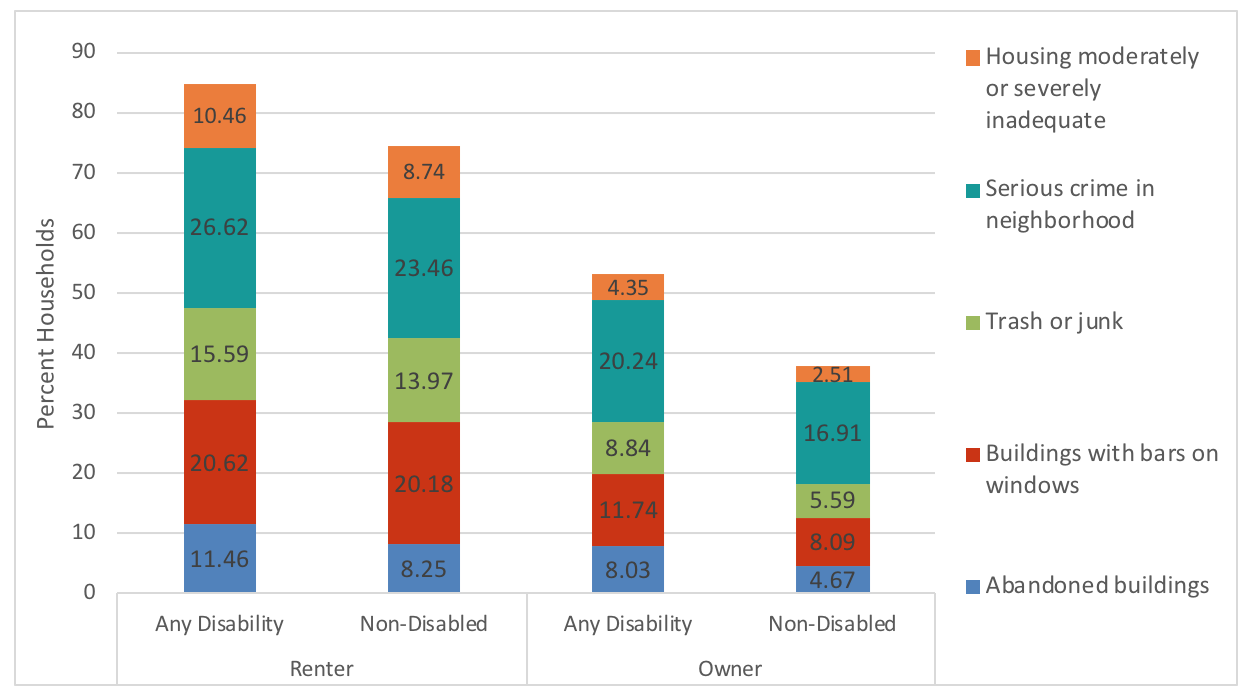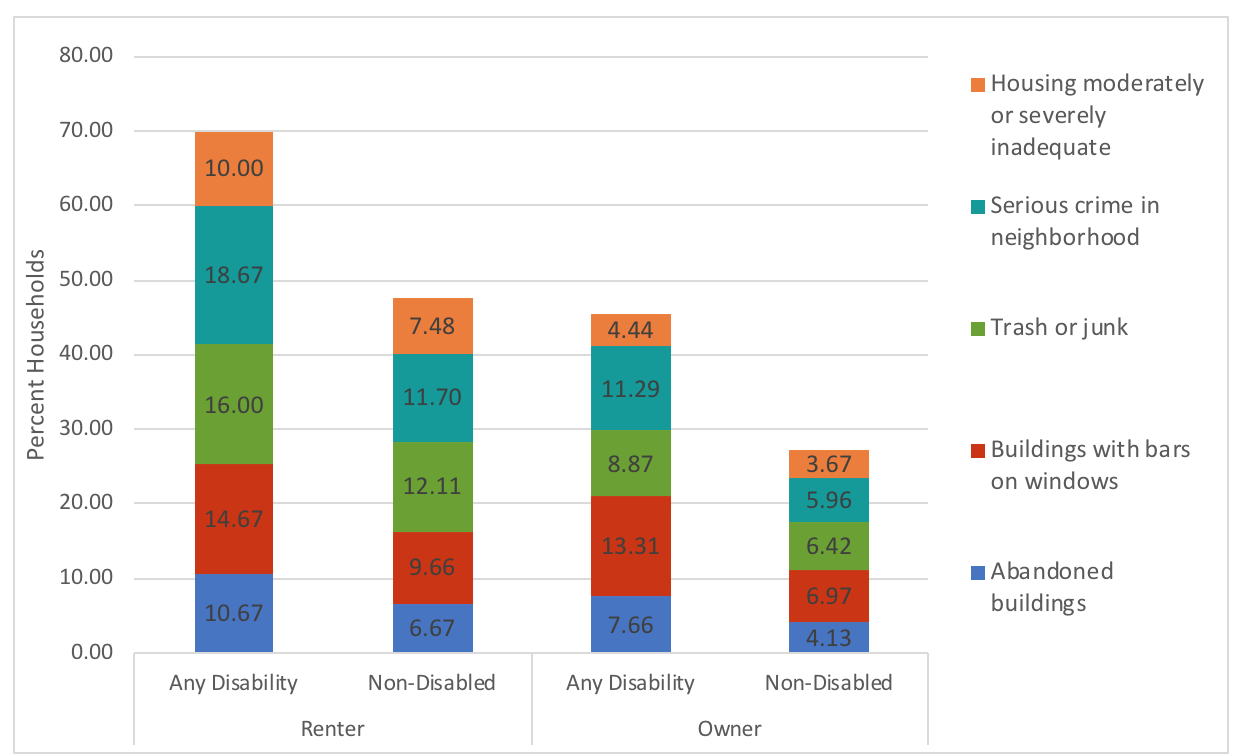Nearly one in 10 Harris County residents has a disability. That's over 400,000 residents. Future projections suggest that as many as 21 percent of households nationwide will have at least one member who is disabled by 2050.
Despite laws such as the Americans with Disabilities Act, giving civil rights protections to people with disabilities, as well as the Fair Housing Amendments Act, prohibiting discrimination in housing sales, rentals or financing, unequal opportunities and access for people with disabilities continue to shape their housing and neighborhood quality. In 2017, the majority of complaints made to the Department of Housing and Urban Development alleging housing discrimination were based on disability status. Nearly 62 percent of complaints alleging housing discrimination were based on disability status, while 24 percent were on the basis of race and 10 percent on national origin.
The sheer number of complaints raises the question of whether households with at least one person with a disability live in a more disadvantaged neighborhood than households without people with disabilities. In a recent national study, my colleagues and I found that households where at least one person has a disability reported more housing and neighborhood deficiencies. Comparing renters to owners, owner households with at least one person with a disability experienced more residential disadvantages than renter households with at least one person with a disability.

Reported Neighborhood and Housing Quality by Disability Status and Housing Tenure: Nation.
There are fewer disparities among disabled renters and owners than among non-disabled renters and owners. In terms of significant differences between disabled and non-disabled households, owners reported more disadvantages than renters. Eight percent of owner households with any disability reported the presence of abandoned buildings in their neighborhood, compared to less than 5 percent of households with no disabilities. More owner households with a disability reported trash or junk, buildings with bars on windows, serious crime and inadequate housing than owner households without a disability.
In the Houston metropolitan area, according to recently released data from 2017, households with at least one person with a disability experienced more residential disadvantages in housing quality and across all neighborhood quality indicators compared to households without disabilities. Those results followed the same patterns as the nation for both renters and owners.

Reported Neighborhood and Housing Quality by Disability Status and Housing Tenure: Houston Metropolitan Area.
Further results at the national level revealed similar patterns when comparing households with a person with an ambulatory disability and households without any disabilities. A lack of open spaces emerges as a significant difference when comparing households with at least one ambulatory disability to households without any disabilities.

Reported Neighborhood and Housing Quality by Ambulatory Status and Housing Tenure: Nation.
In terms of statistical odds, the odds of households with at least one disability reporting poor neighborhood conditions was higher on average than households without a disability.
This is further distinguished when comparing by tenure status. For example, the odds of renter households with at least one person with a disability reporting the presence of abandoned buildings in their neighborhoods are 1.40 times higher than the odds of households without people with disabilities, controlling for relevant variables. However, among owner households, the odds are 1.72 times higher.
For renters, the odds of households reporting trash or junk is 1.23 times higher, presence of serious crime in neighborhood is 1.36 times higher, and moderate or severely inadequate housing is 1.33 times higher than households without disabilities, controlling for relevant variables.
For owners, the odds are higher across the board, including buildings with bars on windows, which is 1.37 times higher than households with people without disabilities.
It could be the case that people with disabilities live in areas that are overall more disadvantaged than people without disabilities. Neighborhood conditions such as crime, trash, bars on windows and abandoned buildings likely indicate poorer school quality and lower incomes.
They also may have less residential mobility, perhaps reflecting a lack of options. Regardless of tenure, households with at least one disabled person remained in their homes longer than households without people with disabilities. Among renters, households with at least one disabled person lived in their house for an average of 6.25 years, while households without any disabilities lived in their house for an average 4.04 years. Among owners, household with at least one disabled person lived in their homes for an average 20.96 years, yet households without any disabilities lived in their house for an average 12.63 years.
Furthermore, identifying as a racial-minority, female or low-income can serve to intensify or compound the barriers faced by people with a disability. Personal disadvantages such as these are often correlated with neighborhood disadvantages. In a county as diverse as Harris County, accounting for the intersectional demographic factors comprising neighborhoods is critical.
The following tool allows you to quantify the percent of disabled residents in your neighborhood by type of disability, sex, age group, race, poverty status and whether the disability was sustained in service. This breakdown differs from other visual representations of people with disabilities across Harris County because it looks solely at people with disabilities rather than their percent of the total population.
By selecting a “disability measure," users can see the distribution by type of disability, sex, age, race and poverty status of people with disabilities in a given neighborhood. Users can optionally select a neighborhood, shown here as community tabulation areas, to focus on the demographics just within the neighborhoods of your community.
Looking at the overall Harris County distribution, residents with ambulatory difficulties appear to be a predominant type of disability, with higher percentages evenly dispersed across the county. Residents with two or more disabilities is similarly high across the county.
Drilling down to specific CTAs, in the Uptown CTA for example, more residents with disabilities are over the age of 65. In pockets of the Fifth Ward, nearly 50 percent of residents with disabilities are also below poverty. In parts of Clear Lake, 52 percent of residents with disabilities sustained that disability in service. In parts of the Third Ward, nearly 93 percent of residents with disabilities are between the ages of 18 and 34. In parts of Five Corners, nearly 80 percent of residents with disabilities are African American.
It is important to recognize any intersectional disadvantages residents with disabilities may be experiencing, but also how that might manifest in neighborhood and housing conditions. Further data collection specifically in Houston regarding housing and neighborhood conditions of people with disabilities may be needed in order to target appropriate neighborhood and housing improvement strategies.
For now, organizations and city committees such as the Mayor’s Office for People with Disabilities and the Houston Commission on Disabilities can consider making recommendations to city council members to improve housing and neighborhood conditions in neighborhoods with higher intersectional disadvantages including neighborhoods with residents with disabilities.
According to Facilities Management Division in Houston Parks and Recreation Department, Michael Isermann, Complete Communities are currently priority areas for certain neighborhood improvements; however, those areas were not selected based on disability status.
The MOPD and HCOD could use information on the size and distribution of these intersectional disadvantages in conjunction with the housing and neighborhood disparities of people with disabilities to distribute funds or develop programs or projects for the improvement of housing and neighborhoods for residents with disabilities.
Please see HCDC Dashboard for further data and visualizations on the distribution of people with disabilities across Harris County.

